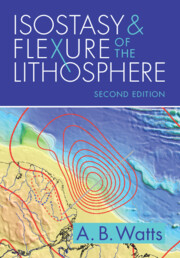Book contents
- Isostasy and Flexure of the Lithosphere
- Isostasy and Flexure of the Lithosphere
- Copyright page
- Dedication
- Contents
- Preface to the Second Edition
- Preface to the First Edition
- Acknowledgements
- Notation
- 1 The Development of the Concept of Isostasy
- 2 Isostasy and Flexure of the Lithosphere
- 3 Theory of Elastic Plates
- 4 Geological Examples of the Flexure Model of Isostasy
- 5 Isostatic Response Functions
- 6 Isostasy and the Physical Nature of the Lithosphere
- 7 Isostasy and the Origin of Geological Features in the Continents and Oceans
- 8 Isostasy and the Terrestrial Planets
- References
- Index
7 - Isostasy and the Origin of Geological Features in the Continents and Oceans
Published online by Cambridge University Press: 28 September 2023
- Isostasy and Flexure of the Lithosphere
- Isostasy and Flexure of the Lithosphere
- Copyright page
- Dedication
- Contents
- Preface to the Second Edition
- Preface to the First Edition
- Acknowledgements
- Notation
- 1 The Development of the Concept of Isostasy
- 2 Isostasy and Flexure of the Lithosphere
- 3 Theory of Elastic Plates
- 4 Geological Examples of the Flexure Model of Isostasy
- 5 Isostatic Response Functions
- 6 Isostasy and the Physical Nature of the Lithosphere
- 7 Isostasy and the Origin of Geological Features in the Continents and Oceans
- 8 Isostasy and the Terrestrial Planets
- References
- Index
Summary
Irrespective of dynamic topography, flexure influences landscape evolution in many tectonic settings. The shape of a flexural rim flank uplift formed by loading or unloading of the crust, for example, can induce a family of river systems in the landscape including dip, scarp and break-through streams. The strongest evidence of flexure’s influence though is from studies of large river systems in fold and thrust belts which incise sufficiently to unload the crust and form anticlines and in foreland basins where rivers exiting a fold and thrust belt may be redirected by flexure to flow along structure.
Perhaps most importantly, flexure affects structural inheritance and the Wilson Cycle. The Earth’s elastic lithosphere that can retain a memory of a geological event, appear both strong and weak on long timescales, and support stresses of hundreds of MPa ensures that flexure will play a role in explaining structural inheritance. Inheritance plays a major role in evolution of sedimentary basins as they morph from one type to another, in orogenic belts where thin-skin and thick-skin tectonic styles may vary along strike a fold and thrust belt, and in the Wilson Cycle where continents disperse and reassemble and oceans open and close.
Keywords
- Type
- Chapter
- Information
- Isostasy and Flexure of the Lithosphere , pp. 341 - 470Publisher: Cambridge University PressPrint publication year: 2023

